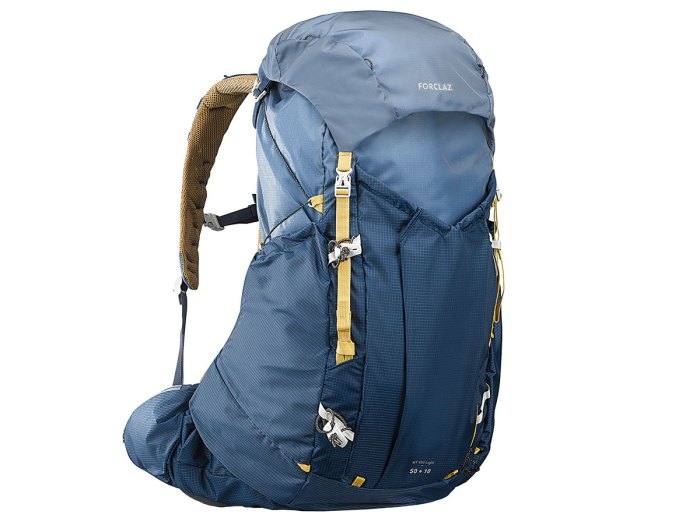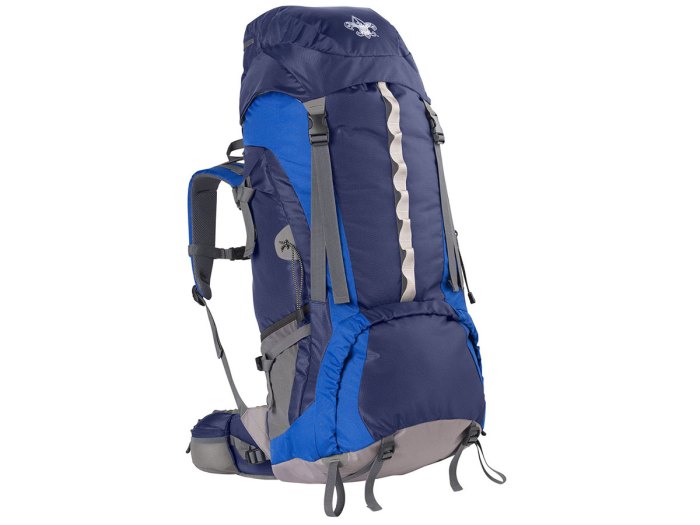Pick the Best Backpack With These Expert Buying Tips

Your backpack and boots are the two pieces of gear you’ll use the most on the trail.
“A pack that fits poorly can make or break your trip,” says Ryan Wichelns, editor-in-chief of Trails Magazine, a lifelong backpacker and former Scout from Stillwater, New York.
“Buy one that fits your body and your gear.”
When shopping for a backpacking pack, the most important thing is to try some packs to see what works, he says. A pack might look cool online but be a bad fit. Everybody is shaped differently. To get the right size, measure your torso length and hip size.

Backpacking experts Ryan Wichelns and Jenn Cadorette.
THE RIGHT FIT
An expert at your local outdoor shop can help you find the best backpack. Some outdoor shops also sell used packs. If you can find one in good shape that fits, a used pack can be a great way to save a few bucks.
Put some weight in a pack and walk around the store for a few minutes. You’ll start to notice what fits your back, shoulders and hips best. Many backpacks have adjustable torso length. That is great for people who are still growing.
The weight of a loaded pack should rest on your hips, not pull on your shoulders. Once your pack is on, watch out. Your hip belt can slide down and compress your butt, back and leg muscles, which keeps them from working right.
“Hip muscles come up higher than you think,” says Jenn Cadorette, a physical therapist and thru-hiker. “Put your hands on your waist and find your hip bones. Your backpack hip belt should stay on those bones.”

PACKING YOUR BACKPACK
How you pack your backpack is as critical as your pack’s fit.
“Pack your heaviest gear close to your back,” Cadorette says. “That will help you stay balanced when you’re hiking.”
Packs are measured in liters. For backpacking, you’ll likely need a pack that’s 35 liters or larger. Buy a pack that’s big enough to carry what you need, but not one that’s too big, or you’ll carry extra pack weight and be tempted to overload.
A versatile pack will have lash points for strapping gear on the outside, though you first want to focus on the inside. For winter backpacking, you’ll need more space for a warmer sleeping bag, extra food and clothing. Less weight is easier and more fun to walk with, but every backpacker must decide what non essential to bring and what to leave at home.
Check Scout Life’s outdoor essential checklists at go.scoutlife.org/essentials
Our favorite backpacks have features that make hiking easier. Hip belt pockets let you grab snacks, your phone and sunscreen without stopping. If your pack doesn’t come with one, you can get one that slides over your belt.
A good pack also lets you drink without taking off the pack, whether it’s a built-in space for a hydration reservoir or easy-to-reach place for a water bottle. The pack should have at least one pocket to organize gear you want to access fast, like water treatment gear, pocketknife and flashlight.
Another nice feature is a lid — or a “brain,” as Wichelns calls it — that can fully unclip so you can easily take your essentials with you into your tent instead of bringing in the whole pack.
Once you’re home, empty and dry your pack. Spot wash the pack with dishwashing soap and a sponge. Maintain your gear, and it’ll last longer.
THE BEST BACKPACKS

Granite Gear Perimeter 50
The Granite Gear Perimeter 50 ($250, granitegear.com) is a simple minimalist pack with loads of great features. The adjustable torso and hip belt fit many people and make the pack one you can grow into. It comes in regular and long torso lengths. The padded, contoured hip belt has big pockets for your gear. Granite Gear’s suspension system is comfy, with articulated, adjustable shoulder straps. The rolltop pack has two stuff pockets on the front and a zippered lid. A bottom flap holds your sleeping pad or tent. A zippered pocket in the flap stores your wet rainfly away from your other gear. Everything else goes in the main compartment. Once your pack is loaded, compression straps cinch it down so you can use this pack comfortably for weekend hikes or bigger projects, like a thru-hike. The Perimeter will last a long time; it’s made from Robic high-tenacity nylon, which is 50% stronger than regular nylon.

Forclaz MT900 UL 50+50L
At 2.9 lbs. and 60 liters, the ultra-versatile Forclaz MT900 UL 50+10L ($189, decathlon.com) is one of the most affordable large-capacity packs. With seven pockets, a hydration reservoir sleeve and clips for trekking poles, it’s ready for any trip. The MT900 lets you access gear through the top or the full side-zip. It’s a great pack for sweaty hikers because a mesh hammock lifts it off your back for airflow, and the shoulder straps and hip belt are highly perforated and covered in mesh for maximum airflow. Side cinching cords take some time to get used to, but ample lashing points and an included rain cover made this pack a top choice. So does the 10-year warranty.

REI Kid’s Tarn
You might find a kid’s pack fits you better than a pack sized for adults. The REI Kid’s Tarn ($119-$165, rei.com) has the quality and features of an adult pack but in sizes made for kids. The 40-liter version, weighing 2 lbs., 10 ounces, is for torsos down to 12 inches. It has enough internal space to suit smaller kids. For bigger kids and longer trips, the 65-liter Tarn, at 3 lbs., 14 oz., has a traditional design with a zippered sleeping bag compartment and top access. The 65-liter pack has dual oversized water bottle pockets, a hydration sleeve and a vented front shove pocket. Its removable lid has backpack straps, so you can leave your big pack behind for short hikes. This pack’s hip belt has a stiffener and thick foam to take the bite out of carrying a heavy load. The harness uses channeled foam for airflow to keep you from getting too sweaty.

Kelty Asher 55
The Kelty Asher 55 ($139, kelty.com), at 3 lbs., 2 oz., has many of the same features as more expensive packs: an adjustable torso, big water bottle pockets, separate sleeping bag access and front-of-the-pack places for strapping overflow gear, but it doesn’t have a removable lid or hip belt pockets. Still, it’s great if you’re on a tight budget. The broad hip belt and airflow back also make this a great first pack.

Nomad RT 50
With a roll-top design, the Nomad RT 50 ($230, alpsmountaineering.com) allows you to compress or expand your pack’s main compartment volume, increasing your overall space to 60 liters or pressing it down to 40 liters. At nearly 5 lbs., the pack is covered in straps and attachment points for fastening gear. This pack comes in 38- and 75-liter versions, too. ALPS Mountaineering offers gear discounts exclusive to Scouts through its Hiker Direct program. For the RT 50 pack, Scouts can get up to 40% off through the program.

BSA Mountaineer 70L backpack
If you have a long gear checklist, the BSA Mountaineer 70L backpack ($120, scoutshop.org) has room to fit all your gear. This 4 lb., 70-liter pack features designated spaces for your sleeping bag, hydration bladder and gear you need to access quickly. You’ll have plenty of storage with its outside mesh pockets, easy-access side pockets and hip belt pockets — plus there’s a place to attach your trekking poles. The pack is designed to feel lighter with its reinforced lumbar support system and adjustable straps.
Hi! I’m looking for a really sturdy backpack. I want to start backpacking for at least three days (hopefully more!). I’m around 5’4 and I need a pack that will be able to hold my tent, sleeping bag/pad and cooking gear and the rest of my supplies. IS THERE A REALLY DURABLE PACK OUT THERE FOR LESS THAN $200?
You can get what you need for like 80 bucks good luck on you hike
I have a super durable pack mine was about $310 but is the best pack that youy could ever want. Aether AG70 i have back packed with this pack for 3 years and have taken it on 10 day trips. would really suggest it.
I’m 4,7 ish what is a good pack
I’m about 5 ft2 and need a knew pack to start Boy Scouts. I’m about 95-100 pounds and I would prefer an internal framed pack. I live in New Hampshire, and there is rugged terrain and snow. Does anyone have a suggestion for a pack that’s under 180 that can stand these conditions and hold lots of gear?
Using terms like “smaller guys and “larger guys” in your articled is not very helpful. How small is “smaller” and how large is “larger”? Since scouts’ sizes can range between a small 7 year-old and 6-foot tall teen I have no idea where my tall 10 year-old’s size falls along your two-category spectrum.
Matt — Torso size, as described in the article, is the most important measure. If you measure your son, it will give you an idea which packs listed in the article would fit him. I think the term “smaller guys” you are referring to is in the description of the REI packs; I’ve looked at those packs for my son as well, and if you look at the torso length specs at REI, you’ll see what they mean. The Passage 38 would probably fit most boys down through Cub Scout ages, while most boys 11 -18 would fit the 65.
I need a backpack for a 4′ 5” person, any suggestions?
Use a teton!!!!
I would recommend the Gregory Wander! I’m exactly 4,5 and it’s fits me very well. They also come in a 70L model for $199
I was looking at an osprey under at 190$, but then I found the Back Diamond epic 45 at 123$, small, i am 5 foot 6 and am looking for a pack to last 3 to even a week hiking. Very rugged terrain. Any suggestions?
I have an osprey kestrel 48 that works great and I’ve held gear for 8 days in it and I’m gonna use it at philmont
i would go with a kelty red cloud
if your a smaller frame you can even go with womens sizes.
but kelty or gregory are the best in my opinion.
osprey are so expensive and i feel they dont hold up!
don’t forget about frameless packs they are a little bit hard to pack though because you have to do it precisely
Frameless packs are not really made anymore.
yes they are that’s basically what most ultralight packs are.
I bought a really good quality backpack at a thrift store for $20. It was really lightly used. Just shop at a thrift store and save a TON of money.
I’m looking for a good pack for a younger scout that would fit for someone five foot three and is very light. I’m looking for something under $150
Ozark trail explorer 45l $59
yah but I’ve never found something like a backpack even in mildly good condition.
I prefer using day packs without a any frame in them at all for multi day backpacking trips . I like the way it feels on my back and shoulders